The Houses of
the Horoscope
The twelve houses of the horoscope provide a backdrop and setting for the drama of human experience. If you’re searching for the setting of your next story or scene, you don’t need to look any further than a horoscope chart.

The planets and signs all come together in a horoscope chart—a visual snapshot of the sky at a given point in time. Like a map of the cosmos, it’s a convenient way to pinpoint the positions of the planets as they move through the signs of the zodiac.
On paper, the zodiac is charted like a circle—which reflects our view of the solar system, looking out at space from our vantage point on Earth.
The chart is divided like a pie into twelve sections, or houses. That term comes from ancient astrologers who believed that each house of the horoscope was the dominion of a god.
In the next few pages, we’ll learn how to read a horoscope chart. For now, however, we’ll focus on the basic symbolism of the twelve houses.
Zodiac Houses
Each house of a horoscope naturally corresponds to one of the twelve signs of the zodiac—and from a symbolic standpoint, each house describes a specific focus on a separate area of life.
Here’s a brief overview of the significance of each house, along with their ruling signs and planets. You’ll probably notice some overlap between the symbolism of each house and its corresponding sign.
|
House |
Rulership |
Ruling Sign |
Ruling Planet |
|
First House |
Physical appearance, first impressions, self-awareness |
Aries, the ram; associated with leadership |
Mars, planet of energy, self-assertion, and aggression |
|
Second House |
Money, possessions; values security, creature comforts, material resources |
Taurus, the bull; associated with property |
Venus, planet of love and attraction |
|
Third House |
Communication, thought process, learning style, siblings, neighborhoods |
Gemini, the twins; associated with communication |
Mercury, planet of speed and communication |
|
Fourth House |
Motherhood, home, family, emotional well-being, the ability to nurture and be nurtured, intuition |
Cancer, the crab; associated with protection and nurturing |
The Moon, orb of reflection and feminine cycles |
|
Fifth House |
Creation, |
Leo, the lion; associated with courage and showmanship |
The Sun, source of energy and enlightenment |
|
Sixth House |
Work, duty, responsibility, service to others, health, attention to detail |
Virgo, the virgin; associated with health and cleanliness |
Mercury, planet of speed and communication |
|
Seventh House |
Marriage, partnerships, intimate relationships, balance, social skills, open enemies |
Libra, the scales; associated with justice, equality, and balance |
Venus, planet of love and attraction |
|
House |
Rulership |
Ruling Sign |
Ruling Planet |
|
Eighth House |
Sex, death, joint resources, other people’s money |
Scorpio, the scorpion; associated with the dark mysteries of life |
Pluto, planet of death, resurrection, and unavoidable change |
|
Ninth House |
Philosophy, long-distance travel, higher education |
Sagittarius, the archer; associated with honesty and exploration |
Jupiter, planet of luck and expansion |
|
Tenth House |
Ambition, status, career, public image, fathers and authority figures |
Capricorn, the goat; associated with work and rewards |
Saturn, planet of structure, foundation, boundaries, and limitations |
|
Eleventh House |
Social groups; causes; futuristic, long-term thinking |
Aquarius, the water bearer; associated with visions of a better world |
Uranus, planet of independence, revolution, and rebellion |
|
Twelfth House |
Psychic ability, the occult, hidden places, subconscious mind, psychological health |
Pisces, the fish; associated with intuition |
Neptune, planet of mysticism and illusion |
Creative Guidance
When you create characters, you’ll need to know a lot about them. Filling in the wheel of a horoscope chart is a good starting point. You’ll find a slot for every detail: physical appearance, possessions, childhood, family, hobbies, children, dietary habits, partners, philosophy, religion, higher education, career, social status, friends, dreams, and secrets. All have a place in the houses of the horoscope.
Behind the Scenes:
Setting as Character

Cities, states, and countries all have birth charts—just like people do. The charts are based on the date and time of their founding, usually as documented by official records and articles of incorporation.
The United States, for example, was born on the Fourth of July, which gives it a Cancerian Sun. Cancerians are fiercely patriotic, nurturing, and emotional, but they’re also driven to lead and take care of others. The United States also has a Sagittarius ascendant, which adds a dash of bravery, daring, optimism, and outspokenness to its people as a whole.
A well-developed setting can add character to any story—and even take on a life of its own. The environment your characters choose—or find themselves thrust into—offers challenges and benefits.
You can model your environment on planetary symbolism. Will your setting be harsh and unforgiving, like Saturn, or mystical and dreamy, like Neptune? Will your characters find themselves submerged in Pluto’s underworld, or bounding across the low gravity of the Moon?
You could also choose to play with the imagery of the signs. Picture the possibilities that the elements present, as your characters find themselves in places that are earthy and grounded, watery and emotional, airy and intellectual, or fiery and spirited. Will they be engulfed in the fiery enthusiasm of Aries, Leo, and Sagittarius? Surrounded by the intellectual ideals of Gemini, Libra, or Aquarius, or submerged in the deep waters of Cancer, Scorpio, and Pisces? Maybe they’ll focus on the earthy realities of Taurus, Virgo, and Capricorn.
The backdrop of your story can make or break your characters. Does it propel them or suffocate them? Does it provide drama and conflict? Is it a friend or a foe? Does it provide structure and guidance? Are there places where your characters can find sustenance and support? Does it offer obstacles that can be overcome, with room for growth? Will they stake their claim and live or die there?
How can your characters turn the setting to their advantage? The setting will become a part of them, for good or bad, where they discover their truest selves. Even scenes can be set in places that will reflect your characters’ personalities, where they can blend into the crowd or set themselves apart.
Creative Guidance
The houses of the horoscope aren’t merely symbolic. Each one can be linked to a clearly defined landscape. While you’ll probably want to develop your own associations, here are some starting points.
• Aries—a hot, dry desert
• Taurus—a cool green pasture
• Gemini—the clear blue sky
• Cancer—a shadowy, moonlit land
• Leo—a tropical jungle
• Virgo—a farmer’s field
• Libra—a pleasant meadow
• Scorpio—graveyards and the underworld
• Sagittarius—a college campus
• Capricorn—a mountaintop
• Aquarius—outer space
• Pisces—an ocean
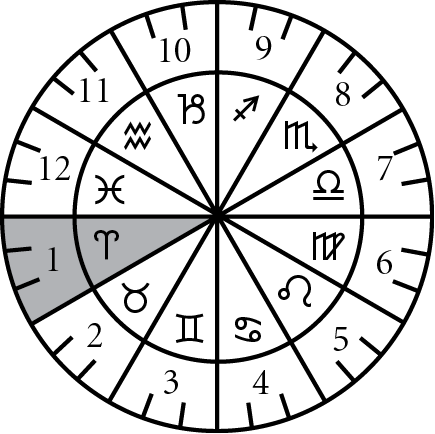
Image and Identity
Think of each house of the horoscope as a scenic backdrop, and you’ll be able to evaluate the planets and signs that make every horoscope chart a unique place for a story to unfold.
The first house reveals the first thing you’ll notice about anyone you meet—including your fictional characters. When the curtain rises on the first house of the horoscope, viewers see the stage for the first time. The first house establishes the time and place of a story, and anchors its characters in a fictional world. It’s the house of physical appearances and first impressions, as well as the face we show the world. Occasionally, it is a façade. What you see isn’t always what you get.
In literature, the first house is the main entry to the story. It’s where readers can make a quick decision about the mood, tone, theme, and type of story. It’s not fair to trick them with false starts or empty promises; make sure your establishing shot sets up the story you really want to tell.
In the natural zodiac, the first house is ruled by Aries, the sign of leadership and initiation. Aries is ruled, in turn, by Mars, the red planet of action, self-assertion, and aggression. Mars accentuates Aries’ daring nature, and powers its drives and desires.
In real life, however, the earth is constantly revolving through the zodiac, so any of the twelve signs could mark the first house in a horoscope.
No matter what sign is on the cusp—or in the house—the first house will always be somewhat Arian in nature, and planets in the first house will always take on some of Mars’s energy. And because the first house is so prominent, any planets here will be important indicators of personality, story, and setting.
Scenery and Setting
Most stories open with drama and action—which is just what you’d expect from Mars, the ruler of the first house. Mars is the ancient god of war, and when he steps into the spotlight, you can expect crisis and conflict. No one wants to read about an ordinary day in an ordinary life, and Mars delivers by offering us a wide range of tragic accidents, crimes against humanity, and physical and psychological attacks.
On a practical level, Mars’s association with war links the first house to forts, armories, battlefields, and sports arenas. Mars’s command of iron and weaponry connects the first house to factories, machine shops, tool sheds, junkyards, and hardware stores, as well as surgical centers, dental offices, and even barbershops.
Aries, the sign of leadership and initiation, also rules the first house. You can use its fiery elemental association to inspire scenes in dry, hot places, like bakeries, furnace rooms, boiler rooms, steel plants, and forges.
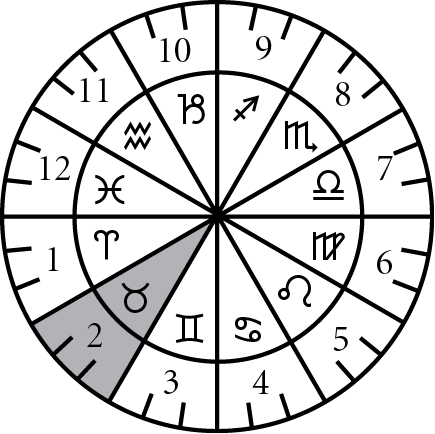
Treasured Possessions
How much money do your characters have? How do they earn it? How do they spend it? Take a peek into the second house, and you’ll spot important clues about their financial situation, as well as their spiritual values. You’ll even get a glimpse into their own self-worth.
The second house is the house of money, treasures, and possessions. It’s ruled by Taurus—which is ruled, in turn, by Venus. Both the planet and the sign are naturally drawn to comfort—even opulence. They favor luxury and tradition, objects of beauty, fine art, and uplifting music.
More importantly, Venus and Taurus crave comfort and security. The signs and planets linked to the second house will show you how secure they truly are, as well as what kind of a roof your characters have over their heads.
Scenery and Setting
Planets and characters in the second house surround themselves with furnishings and belongings that make them comfortable. The second house is also where they can display sentimental treasures, as well as tokens of self-worth and self-esteem.
The scenery of the second house isn’t necessarily designed to impress visitors; it’s there for comfort and convenience. The planets and signs you’ll find in the second house, however, can show you how your characters invest their hard-earned money, as well as how much money they can afford to spend.
When you use the second house to suggest scenery and settings, picture the earthy Taurus bull. He can usually be found in a bucolic countryside, in a meadow or grassy pasture. You can expand that association to imagine more civilized settings of wealth and luxury, like banks, stock brokers, jewelry stores, and high-end gift shops.
Venus, the cultured goddess of beauty and attraction, might also inspire thoughts of museums, art galleries, concert halls, orchestras, opera houses, movie theaters, ballet companies, and Broadway shows.
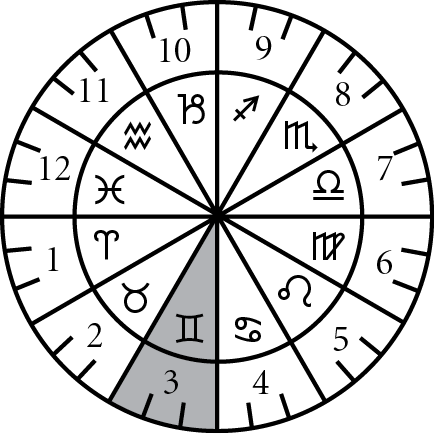
Community and Communication
The third house of a horoscope describes your characters’ neighborhoods—the communities of family and friends they were born into, as well as those they build for themselves.
The small world of the third house is ruled by Mercury, the messenger of the gods. When he was at his peak, his work took him all over Mount Olympus, ferrying communiqués to and from the pantheon of gods—most of whom were related to one another.
The third house is home to the Gemini twins, which links it to sibling relationships. The third house also covers interactions with aunts, uncles, and cousins.
What sort of neighborhood will you choose for your story? Will it be urban and crowded, packed with planetary influences, or wide like the open prairie? Check the sign on the cusp, as well as any intercepted or changed signs within the house. A fire sign might suggest a busy neighborhood, while an earth sign could hint at a bucolic country life. An air sign might be an upscale city skyscraper or a mountaintop community. A water sign could be a beachfront neighborhood—or an island oasis, in or out of civilization. Use your imagination. Let the planets and the signs lead you to your own conclusions.
Scenery and Setting
Gemini, the sign of thought and communication, rules the third house. The sign’s connection to primary education often suggests grade-school settings, including classrooms, playgrounds, lunch rooms, gymnasiums, and auditoriums.
Mercury’s presence will make itself felt in the adult world, too. The god of communication is comfortable in libraries, newsrooms, radio stations, libraries, and bookstores. You’ll find him wherever there’s a computer, a phone, or a stack of mail. He might even lead you to a post office, a telegraph bureau, or a dispatch station.
If you’re looking for an outdoor setting, consider the airy elemental association, and look up, where the air is thin and rarified, or anywhere the wind blows.
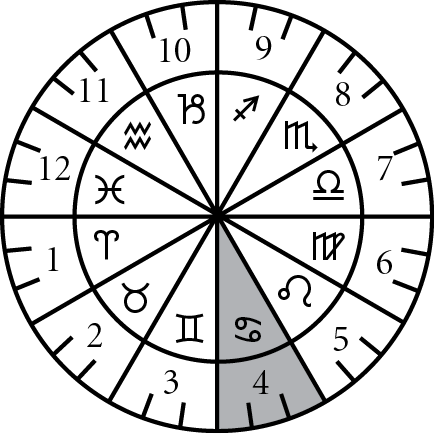
Home and Family
The fourth house is the foundation of the chart, so it describes the emotional foundations of home and family, as well as childhood nurturing and memories. It’s the home base. It’s the place we leave to work and see the world, and it’s the place that beckons us back at the end of the day or the end of our lives.
In the natural zodiac, the fourth house is ruled by Cancer, the sign of motherhood. The sign represents emotional and physical well-being, along with fierce protectiveness. After all, Cancer’s crab carries its home on its back, and fights fiercely to defend it.
Cancer is ruled, in turn, by the Moon, the celestial sphere of reflection and cyclical change. It’s the landscape of memories, dreams, and reflections. The Moon also casts a soft, silvery light on the feminine realm of marriage and children.
Scenery and Setting
The signs and planets in your character’s fourth house reflect their upbringing, as well as the home and family life they’ll try to create for themselves.
A fourth-house setting will probably lead straight to a kitchen—the heart of the home, and the place where both body and soul can find sustenance. Cancer’s love of food also links the fourth house to gardens, fields, pastures, vineyards, and orchards, as well as grocery stores, bakeries, restaurants, cafeterias, and dining rooms. Cancer’s more generalized link to homemaking could also suggest places where we conduct the mundane tasks of family life, like pantries and laundry rooms. Cancer’s association with nurturing could suggest a setting in a nursery school or day care center.
The sign’s connection to family foundations might also suggest a setting in an ancient city, an ancestral homeland, a castle, or a family farm.
The sign’s signature animal, the crab, carries its home on its back. It’s a mobile home. Your characters might be living in a trailer park, or simply camping in a national park.
If you’d like to take your characters outside, lead them to water, and let them spend time at the beach, or near fountains, lakes, rivers, streams, waterfalls, and oceans.
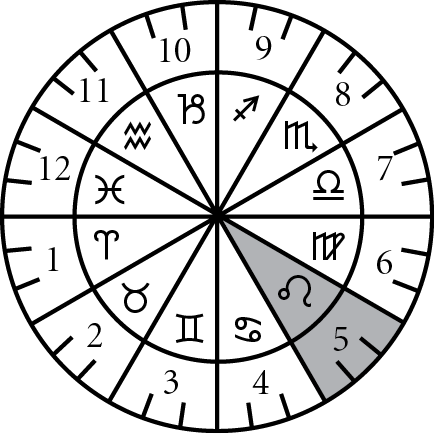
Creation, Recreation, and Procreation
Leo, the king of beasts, rules the fifth house of the horoscope. It’s a lion’s den of amusement and enjoyment, where your characters will find room for creation, recreation, and procreation.
Leo is ruled, in turn, by the Sun, the showman of the zodiac. He uses the fifth house as a stage, where he can perform for the pleasure of his company.
No matter what sign or planet is linked to the fifth house of a chart, planets that land in the rec room will automatically assume a playful, creative energy.
Scenery and Setting
The fifth house is a place for fun and frolic. It’s also a center for arts, crafts, and entertainment. You can think of it as a rec room, a craft room, or a man cave. When your characters want to prove themselves in games of skill and chance, they’ll head for the den. You can also find them there when it’s time to watch the big game on TV.
Leo rules gambling and games of chance, so you might be inspired to set part of your story in a casino, a betting parlor, or a pool hall. Your characters might want a seat at a poker table, or spend time at a golf course or a race track. Leo also likes to play and compete physically, so your characters might need to spend time in a gym, at a fitness center, or on a playing field.
Leo, the dramatic showman of the zodiac, also likes to spend time in places where he can see and be seen, like restaurants, bars, taverns, and nightclubs.
Since the fifth house describes procreation and children, the fifth house of the horoscope could also represent a child’s room.
Don’t forget that the king of the jungle might also find himself back in his natural environs. In captivity, you’ll find him in a zoo or a circus.

Work and Service
The sixth house is the house of work and service—but in the hands of a skilled writer, it can be transformed into a location that’s anything but routine.
In real life, the sixth house of the horoscope describes the primary work you perform in service to others, as well as the work you employ others to do for you. In literature, there’s more room for creativity. The signs and planets connected to the sixth house will reveal the tasks and burdens of your characters, as they manage the responsibilities of daily life. If they’re lucky enough to have staff and servants, you’ll find them here. And if your characters live to serve others, this is where you’ll discover their attitudes and approach, as well as the opinions they keep about their employers.
The sixth house is ruled by Virgo, a sign that specializes in detail. Virgo is ruled, in turn, by Mercury, the planet of thought and communication. Mercury is a dual ruler, who’s also responsible for overseeing Gemini. When he reaches Virgo, the god of communication shifts gears. Instead of merely collecting and conveying information, he focuses on critical thinking and analysis. Characters with a strong Virgo influence are questioning and methodical, and they can drive others to distraction with their attention to detail. Happily, they usually have an office or a study where they can retreat to read and write in quiet.
Scenery and Setting
The most obvious setting for the house of service might be literal: try setting part of your story in the servant’s quarters, a butler’s pantry, or a kitchen galley.
The Virgo virgin, who’s usually pictured holding a sheaf of wheat, is often linked to healthy eating, too. That connection could suggest a garden, farm, orchard, or health-food store. You can also send your characters to a clinic, doctor’s office, hospital, or health spa. If their best efforts fail, send your characters to their sickbeds.
Because pets are a daily responsibility, the sixth house is where you’ll find small animals. As a result, your characters might find themselves in a dog house—literally or figuratively. They might also be found near an aviary, animal pen, petting zoo, barnyard, or pasture.
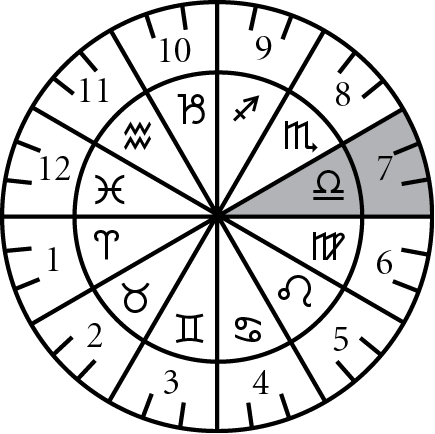
Marriage and Partnership
The seventh house of the horoscope describes marriages, partnerships, and open enemies. Does that sound contradictory? Just spend some time in divorce court.
The seventh house is the place where you can look for information about commitments and lifelong attachments, as well as the closely guarded secrets that bond characters for life. An intimate partner isn’t necessarily a romantic soul mate; many people also place their confidence and trust in doctors, lawyers, clergymen, and accountants.
The seventh house is ruled by Libra, the sign of balance and partnership. The scales of Libra are a reminder that marriage is both a social and a legal institution.
Libra is ruled, in turn, by Venus, the goddess of love and attraction.
Scenery and Setting
With the sign’s and the planet’s focus on romance, the seventh house signifies a place where couples meet—or prepare for an encounter. When you choose seventh-house settings, think of beauty shops, manicure salons, shoe stores, and fashion boutiques, as well as dressmakers, tailor shops, and fitting rooms.
Once your characters are ready for an evening of romance, put them in a taxi and send them off to date-night destinations like five-star restaurants and nightclubs. Let them dance in the Stardust Ballroom, or give them tickets to a concert. As the night winds down, they might even want to check into a motel.
When Venus sets her sights on marriage, you might be inspired to write about wedding chapels, churches, and cathedrals. Will your characters elope to Las Vegas, or say their vows at Westminster Abbey? And after the wedding, where will they honeymoon? If love is blind, it won’t matter whether you send them to the Wisconsin Dells or a private island in the Bahamas.
You can also write about a love nest, an empty nest, or a broken home.
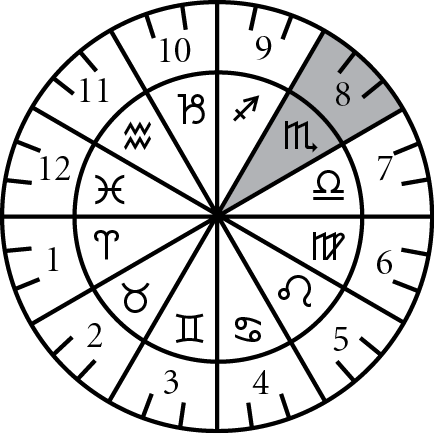
Sex, Death, and Other People’s Money
If a zodiac chart represented a real home, the eighth house would be the bedroom. That’s the place we usually go to sleep, have sex, and die—but not necessarily in that order.
The eighth house is ruled by Scorpio, the master of transformation. After all, we retreat to the darkness for rest and recuperation. We climb into bed at night so we can be reborn in the morning. And when we fall sick at the end of our days, we lie in our deathbed and wait for Pluto’s sweet release.
Pluto, of course, is Scorpio’s ruler. Pluto was the lord of the underworld, which makes Pluto the planet of death, destruction, and deliverance. It’s a chilling fact that planets in the eighth house will often describe how your characters will die—either literally or metaphorically. They might find themselves falling into bed simply to experience the little death of sexual release.
Because sex is traditionally bound to marriage, the eighth house describes joint resources and inherited wealth. Planets and signs in the eighth house can reveal what your characters are willing to pay for intimacy, or what they’re willing to trade in exchange for security.
Scenery and Setting
The eighth-house focus on sex will determine how far your characters will go—and whether the storyline leads them to the bedroom or the back seat of a car.
Since the sign rules unpleasant subjects like death and elimination, Scorpio might prompt you to write about mortuaries—or bathrooms. You might find your characters in a dump ground, recycling facility, underground sewer system, cesspool, or swamp. Death’s bony hand could be literal—and visceral—in a setting like a butcher shop or a meat-processing plant.
Scorpio is fascinated by dark mysteries and secrets. The sign’s connection to the underworld might lead you to think of mob dens, secret rooms, shady massage parlors, speakeasies, and police interrogation quarters.
If you put Pluto in power, you might find your characters whisked into a subway system—or across the River Styx, into the afterlife, or dropped into a living Hell of their own making.
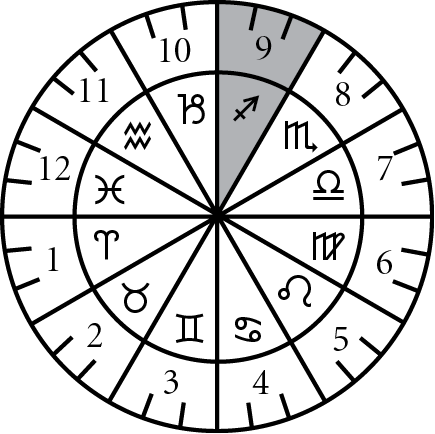
The Higher Mind
While the Library of Alexandria burned centuries ago, its spirit lives on, in the symbolism of the ninth house of the horoscope. It’s where you’ll find every manuscript and every book ever written, in every language. When you reach this point on a chart, you might want to leave your characters to their own devices, and spend some time browsing the shelves yourself.
The ninth house is ruled by Sagittarius, the mythical archer who shoots an arrow across the vast horizon of time and space so he can experience the wonders of a far-flung world.
Sagittarius, in turn, is ruled by Jupiter—the largest planet in the solar system, named for the king of the gods. Jupiter rules the highest realms of philosophy, religious traditions, law, and politics. All told, Jupiter is interested in the moral, ethical, and philosophical reaches of civilization.
Scenery and Setting
Sagittarius is known for a sense of wanderlust and adventure—which could inspire you to write about distant lands and foreign places. The traveling associations of the sign might also take your characters along heavily traveled routes, through airports, train stations, and bus terminals, or down winding roads and highways.
Jupiter’s rule over legal principles could prompt you to set your story in a courtroom or lawyer’s office. Its connection to academics might prompt you to write about the ivory tower of academia, a university campus, or a college classroom. Jupiter’s connection to religious tradition might inspire you to write about churches and temples. Its associated reach into print publishing could push you to set your story in a library, bookstore, magazine stand, or newsroom. Similarly, modern forays into broadcasting—the equivalent of publishing—might suggest a radio or television station.
If you’re going to invoke Jupiter, you could even go all the way and set your story where the king of the gods will recognize himself, like a palace, the Parthenon, or Mount Olympus.
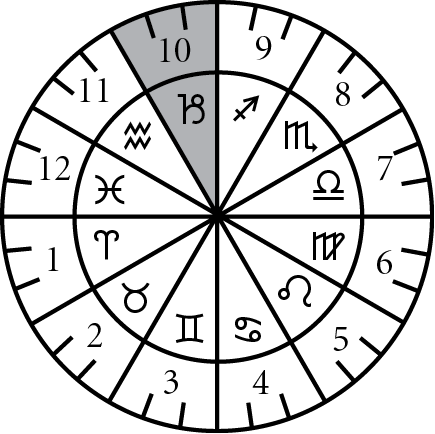
Career and Social Status
The tenth house is the house of career and social status. There, at the top of the chart, you’ll often find characters who have reached the pinnacle of success.
But that’s where the twists and turns begin. Fame and fortune can be cruel, and success always comes at a cost. Characters who seem to be at the top of the world often feel like failures; they might live up to the demands of others, but they can’t live up to the expectations they set for themselves.
The tenth house is ruled by Capricorn, the sign of ambition, status, career, and public image.
Capricorn is ruled, in turn, by Saturn, the ringed planet of limitations, restrictions, boundaries, and structure.
Scenery and Setting
The concept of career and social status might tempt you to set your story in the corner office of a city skyscraper, where your characters can make a name for themselves. Like a tireless mountain goat, they can climb ever higher up the ladder of success.
Traditionally, however, Saturn suggests a darker setting for your stories. Saturn, the ancient god of time and harvest, is a foreboding figure. His long shadow casts a pall—literally—over our lives. His influence could suggest a funeral parlor, cemetery, or church yard.
Historically, Saturn has always symbolized a dry and barren landscape—which means your characters might find themselves cast out of civilization, where they’ll wander across a rocky field, a thorny outcropping, or a barren mountainside. You might want to set them down in a place that has outlived its usefulness, like an abandoned building, a vacant lot, or an overgrown yard.
On a less austere note, Saturn might also inspire a monumental setting, like a courthouse, clock tower, or city hall.

Friends and Fellow Travelers
To move your story forward, your characters need to get out in the world, rub elbows, and find like-minded fellows. You can help them connect with kindred spirits based on the eleventh house—the community center of a horoscope chart.
The eleventh house is ruled by Aquarius, the futuristic sign with long-range, utopian vision.
Aquarius is ruled, in turn, by Uranus, the planet of revolution and reform.
Planets and signs in the eleventh house will reveal the types of friends and social groups your characters attract—or are attracted to. Fire signs are charismatic. Earth signs are practical. Air signs are intellectual, and water signs are emotional and empathic.
Scenery and Setting
In myth and legend, Aquarius is often compared to Ganymede, the cupbearer to the gods. He kept their goblets full of ambrosia, the elixir of life—and ultimately, his service was rewarded and he was given a place of honor in the skies.
In astrology, the traditional imagery associated with the sign features a woman carrying a huge amphora of wine.
What could that mean for your story? You might as well go with the flow and send your characters to a bar, where they can bare their souls to a bartender and drown their sorrows in the bottom of a glass.
Many people think, understandably, that Aquarius is a water sign—but, in truth, it’s an air sign. The wavy lines that constitute the glyph for Aquarius are actually meant to represent waves of water and air. The symbolism suggests that your characters simply need to be wherever people congregate for conversation and debate. You could send them to a coffee shop or a café. The social aspect of the eleventh house might also suggest a country club or a civic center.
You can even tap into the technological association of both Uranus and Aquarius, and arrange for your characters to meet in a computer room, a science lab, or a science-fiction setting, like a spaceship, a satellite station, or a distant planet.

Secrets, Dreams, and Illusions
The twelfth house of the horoscope is a gold mine for writers.
In ordinary astrology, the twelfth house is a storehouse of secrets and repressed memories. It’s the place where we hide our darkest fears, both from other people and ourselves.
As a writer, though, you’re not only unafraid to open forbidden doors and look in locked closets—you’re expected to pry. The twelfth house is where you can find information about your characters’ distant past, hidden enemies, and unspoken, unrealized dreams.
The twelfth house is ruled by Pisces, the sign where mysteries and secrets can be submerged in the watery world of the subconscious.
Pisces, in turn, is ruled by Neptune, the glamorous, mystical visionary immersed in an alternate reality.
Scenery and Setting
In some cases, the twelfth house describes the solitude and confinement of institutions, prisons, asylums, and hospitals. The twelfth house could suggest a sanitarium, convalescent home, convent, or retirement community. Your characters might find themselves there for rest and recuperation—or to work.
Pisces is often associated with drugs and alcohol, so a Piscean reliance on mood-altering substances could drive your characters to drink—or to a wine cellar or a bottle shop. You might choose to plunge them into an opium den or crack house, or send them wandering down a dark alley in search of a fix. You might see them whisked away in a paddy wagon, or sprawled in the back seat of a police cruiser. You could also find them drying out in detox or recovering in rehab. If your characters choose a more natural means to experience altered states, you might find them in a yoga studio or meditation room or at a mountain retreat.
Pisces’ influence also compels some people to spend time near water. Your characters might be drawn to fish tanks and aquariums, or they could don scuba gear and dive beneath the waves to commune with their finned friends. Then again, you might also find them fishing from the comfort of shore, paddling a rowboat or canoe, or perched at the end of a pier.
Creative Guidance
What sort of stories fall naturally into each house of the horoscope? Here are some examples.
• Aries—stories of war, conquest, and exploration
• Taurus—rags-to-riches accounts
• Gemini—stories for children and young adults, as well as journalistic expositions
• Cancer—memoirs and stories about mothers, children, and families
• Leo—stories of action and adventure, sports, and the call of the wild
• Virgo—stories of duty and responsibility; moral tales and fables
• Libra—love stories, romances, and artistic and cultural accounts
• Scorpio—ghost stories and erotic fiction
• Sagittarius—travel and adventure stories, as well as philosophical tomes
• Capricorn—business books and historical accounts
• Aquarius—science fiction and futuristic tales
• Pisces—surreal stories and psychological dramas

A horoscope chart might look like a mystic cryptographer’s puzzle, but it’s surprisingly easy to read—once you know how it’s constructed.
A Panoramic View
The word horoscope comes from the Greek word hora, or “hour,” and skopos, “watching.” It’s a sketch of the solar system, and it depicts what you’d see if you were standing in a particular place on Earth at a specific time.
Wherever you are right now, look around. You’ll notice that you have a 360-degree view of the world around you. Ancient astronomers could see that, too—but they extended that worldview to include the entire sphere of heaven, like a cosmic bubble surrounding the globe.
The exact center of a horoscope chart represents a specific latitude and longitude on Earth. In theory, if you were to stand on that spot, you could look east and west along the horizontal line that separates the top half of the chart from the bottom. That’s because the horizontal line actually does represent the horizon.
From that position, if you were to look straight up, you’d be looking at open sky above your head. And if you were to look straight down, you’d see the earth beneath your feet. In real life, you could only see the top half of the chart from where you were standing. The sky above the horizon would be visible, but the rest of the cosmos would be hidden from view on the other side of the world.
House Positions
The first house of a horoscope chart is always on the left, at the nine o’clock position, and the houses run counterclockwise.
In theory, each house is a 30-degree section. In practice, however, the size of the houses can vary. The earth is tilted on its axis, so from some latitudes, the view of the twelve signs and houses is skewed. Don’t worry about the mathematics that go into chart calculation, because they don’t affect how you read a horoscope.
House Coordinates
As the planets make their journey through the sky, they move through the signs of the zodiac. While the signs of the zodiac offer a fixed backdrop, our view of them changes from moment to moment. That’s because the earth is moving, too, spinning through all twelve signs during the course of a twenty-four-hour day.
Here’s a simple way to picture the difference between the signs and the houses. Pretend you’re in a revolving restaurant at the top of a tall building. As you look out the window, you’ll notice certain landmarks—a park, for example, or a church. Like the constellations and signs of the zodiac, those landmarks are fixed. Your view of them, however, will change as you, and the restaurant—like the earth itself—revolve through space. You could map those landmarks at any one moment, but their relative positions would steadily shift with time.
And the planets? They’re like the cars and trucks you can see down below. They travel down streets and highways, at their own speed, and along their own course. You could map them, too, relative to the landmark signs and houses, just as astrologers plot their positions on an astrological chart.
Planets and Signs
On a horoscope chart, every planet is depicted as a pictograph, or glyph, and listed by the degree and minute of its position in a sign.
The houses are also labeled with glyphs for the signs. The houses run counterclockwise, and the signs of the zodiac always appear in the same order, from Aries through Pisces.

House Cusps
The cusps—the dividing lines between the houses—mark the transition from one astrological sign to another. Even though planets often land close to the cusps, the divisions are firm: a planet can be in only one house at a time. Even so, their energy might be felt in the adjoining house, just as a noisy neighbor can be heard through a wall.
Empty Houses
All ten planets and all twelve signs appear in every horoscope chart. Because the planets are constantly cycling through space at different speeds, however, most charts usually have at least one or two empty houses. You’ll frequently see more than two empty houses, because planets are constantly on the move, and they’re often grouped together.
That doesn’t mean that empty houses are bereft of energy or activity. They’re still ruled by a sign, which means they offer one avenue of expression for the planet that rules the sign. They’ll also be visited, over time, by transiting planets.
The Moon, for example, visits every sign during the course of a month. The Sun travels through all twelve signs every year.
An empty house could even be a good thing: it could indicate that the energy of the sign and house is peaceful and easy, and mastery of its realm comes naturally to the subject.
The Secret History of the Horoscope
For centuries, ancient astrologers watched the Moon rise and set against the backdrop of the zodiac. Night after night, they also watched constellations rise and fall, like clockwork.
In fact, if you were to stand outside every night and watch your favorite stars rise and set on the horizon, you would see the same thing for yourself. You might even notice that the starry backdrop of the zodiac seems to shift about 1 degree every day, so that every 30 days, the Sun rises and sets against the backdrop of a new sign. By the time we go through a full calendar year, we return to the same place we started.
Ancient astronomers used their observations to devise the calendar system we use to this day. The math is simple—but ingenious.
There are 360 degrees in a circle, which roughly corresponds to the 365 days in a year. The zodiac divides perfectly into twelve equal sections of 30 degrees, which led to our division of months. The fact that the system wasn’t exact doesn’t mean it wasn’t easy to adjust; even now, we add a leap day every four years to keep our calendar in sync with the Sun.
You might be aware of the fact that the constellations we see today no longer correspond to the signs of the zodiac. Even though it makes headlines every few years, it’s not news to astrologers. In fact, even ancient astrologers could see that our view of the constellations was constantly shifting and changing. From a symbolic standpoint, it doesn’t matter. Modern astrologers still use the ancient zodiac, because it’s easy to measure, and it’s a fun way to describe the qualities of each sign.
The Oddities of a Horoscope Chart
Reading a horoscope would be a lot easier if it weren’t for the quirks of history and time.
For one thing, the compass points aren’t what you’d expect. On a horoscope chart, the eastern horizon is on the left, and the western horizon is on the right. North is at the bottom, and south is at the top. That’s because charts are constructed from the perspective of the northern hemisphere—which is just where ancient astronomers stood at their posts in Greece and Egypt and Mesopotamia, looking south toward the ecliptical path of the Sun. For that reason, when you read a chart, picture yourself standing on top of the globe, looking toward the equator. East will be on your left, and west will be on your right.
Imagine you’re an ancient astrologer, too, when you consider the signs of the zodiac. Thousands of years ago, when astrologers were first developing the principles of their art, they saw the Sun rise and set against the backdrop of a different constellation each month.
The wheel of the zodiac used to match the constellations—but it doesn’t anymore, because Earth’s rotation isn’t perfectly aligned with the stars. Instead of maintaining a steady orbit, Earth wobbles on its axis, caught in a cosmic tug-of-war between the gravitational pull of the Sun and the Moon. Even so, rather than abandoning or adapting the ancient zodiac, we simply use the signs as a symbolic way to divide space into measurable coordinates.
If our calendar year were 360 days long, it would align perfectly with the 360 degrees in the zodiac wheel. Instead, there are 365¼ days in a solar year. While we can make some adjustments to compensate—by inserting a leap day every four years, for example—we still need a computer, an astrological calendar, an almanac, or an ephemeris to determine just when the Sun will move from sign to sign during the course of any given year.
Creative Guidance
To create a fully rounded character, think like an astrologer.
Astrologers start their assessment of character and personality by assessing the two brightest lights in the sky—the Sun and the Moon, which symbolize the head and the heart, respectively. From there, they move on to the other planets and points in a horoscope chart. Mercury symbolizes the intellect. Venus represents love and attraction. Mars describes primal drives and desire. Jupiter represents growth and expansion, while Saturn symbolizes limitations and restrictions. Uranus adds a touch of the unusual and unexpected. Neptune is the planet of glamour and illusion—the veil that divides dreams from reality—while Pluto brings that curtain of reality crashing down in the end.
Working with Fictional Horoscopes
A horoscope chart is more than just dots on paper. It’s a symbolic master plan that can offer an overview of life’s journey, and outline a drama like a script.
Reading a chart for a fictional horoscope is no different than reading a chart for a real person. While you can analyze every planet in a chart, most astrologers focus on three key points.
The Sun. The Sun is the central focus of any horoscope chart. In a natal chart, it describes the essence of the self—the burning passions and desire that drive a character. Start your chart assessment by noting the Sun’s sign and house placement, as well as its element (fire, earth, air, or water) and mode (cardinal, mutable, or fixed).
The Moon. The Moon’s position describes emotional makeup—the psychological needs and desires, based on inborn characteristics and early upbringing. It symbolizes emotion, memory, and mood. Just as you did with the Sun, consider the Moon’s sign, house, element, and mode.
The Ascendant. In a natal chart, the ascendant, or rising sign, is the face you show the world. It’s based on the sign that was rising on the eastern horizon at the moment of birth, and it symbolizes first impressions, physical appearance, and disposition. The ascendant is also the cusp of the first house. You can find it at the nine o’clock position on the chart. In actual use, it embodies a lot of the same associations you’ll find in the first house.
Creative Guidance
You don’t need to be a master astrologer to be inspired by a horoscope. In fact, it’s good practice to create a completely fictional horoscope for your character. Simply invent a birth date, a birth place, and a birth time. Plug the data into any chart calculation software, online or on your computer, and print it out.
Just remember that a horoscope is merely a map. The planets are pictured as glyphs, and they’re positioned by house and sign. The little numbers next to each planet are simply their mathematical coordinates—the degrees and minutes of each sign.
You’ll see an entire universe of personality traits unfold. Use the descriptions of the planets and signs in this guide as a starting point for your character’s story.
Practice Chart
Here’s a practice chart you can try right now, for a fictional character we’ll call Miss M.

Miss M
September 15, 1890 / 4:00 am UT / Torquay, United Kingdom
Placidus Houses
• The Ascendant. Let’s start with first impressions. Look at the rising sign—the glyph that marks the first house, on the far left of the chart. (You can see the house numbers on the inner wheel, and the zodiac signs on the outer wheel.) So what does Miss M look like? Virgo is on the ascendant, and it takes up the entire first house. That suggests that Miss M looks prim and proper, and she pays keen attention to detail.
• The Sun. How does she think and see the world? Look for the Sun, the marker of one’s focus and worldview. In this case, the Sun is in the first house; it’s also in Virgo, the sign of conscientious duty and service to others.
• The Moon. Finally, find the Moon, the luminous orb of memories, dreams, and reflections. In astrology, the Moon describes a character’s emotional makeup—and in Miss M’s chart, you’ll see it in the second house, not far from the Sun. Miss M’s Moon happens to be in Libra, the sign of partnership and balance.
That was easy, right? Already you can start to see a character take shape. If you were to study every planet in the chart, by sign and by house, you could quickly work up a complete personality profile.
In fact, this chart actually belongs to a real person—mystery writer Agatha Christie, the creator of an amateur detective named Miss Marple.
Don’t let the facts get in the way of your imagination, though. Keep playing with the planets, signs, and houses, as you develop characters, stories, and scenes of your own.
Twenty Questions
1. Think about a story you’d like to write. Where would your characters live? Which house of the horoscope would each of them call home?
2. What would each character see from his or her home?
3. How would that environment shape or change them?
4. How would they feel about their homes?
5. Try moving your hero’s home base from house to house. Experiment with combinations that will add drama and conflict to your story. If your hero is naturally fiery, for example, try moving him into a watery, airy, or earthy house. How will he cope? What changes will he be forced to make?
6. Send your hero on a trip through all twelve houses. What landmarks could he expect to see at each stage of the journey?
7. Start two characters on journeys at different points of the zodiac wheel. Write their stories in parallel, as seen from their two separate vantage points.
8. What sort of story could you write based on the symbolism of each of the twelve houses?
9. Describe the vastly different landscape of each house of the horoscope, as you might use them in a story.
10. Calculate a horoscope chart, either based on a specific date, a key moment for your story, or a time and place chosen completely at random. (You can use astrology software or a free online service like astro.com to do the calculations.) Study the sign that marks the first house. What could that tell you about the setting of your story?
11. What could it tell you about the hero of your story?
12. Look for the Sun in a horoscope chart, and use its position to inspire the setting for a crucial scene in a story. Start by examining the symbolism of the house itself. Is it a public place, or is it private? Describe it.
13. Next, consider the sign. Is the Sun in an active fiery or airy sign, or a quiet earth or water sign? What sort of information can that add to your scene?
14. Now think of the Sun in terms of character development. What can you know about a character’s focus based on the Sun sign? What can you tell about his or her surroundings based on the Sun’s house position?
15. Find the Moon in a chart, and use it to discern a few telling details about your hero’s partner or companion. Does it seem as though a character based on the Moon’s sign will be sympathetic and understanding, or will she prod your hero to make changes and take action? There’s no right or wrong answer; simply use the symbolism associated with the Moon’s sign and position to trigger your imagination.
16. The Moon’s position might also inspire you to develop detailed associations about your hero’s childhood memories or his relationship with his mother. How would you interpret it in that light?
17. Look at the ascendant, or rising sign, that marks the first house of a horoscope. If the chart was calculated for a story, what would the ascendant say about the general setting?
18. If the chart belongs to a character, what can the ascendant tell you about his appearance? What sort of first impression would he make?
19. Are the planets grouped together in any of the houses or signs? What can that tell you about the focus of your story or its characters?
20. If you have some time to experiment, evaluate all of the planets in the chart, by sign and by house. Feel free to use the quick reference guides in the back of this book to compare and contrast the symbolic significance of the planets, signs, and houses.
Physicists say we are made of stardust. Intergalactic debris and far-flung atoms, shards of carbon nanomatter rounded up by gravity to circle the sun. As atoms pass through an eternal revolving door of possible form, energy and mass dance in fluid relationship. We are stardust, we are man, we are thought. We are story.
—Glenda Burgess, The Geography of Love: A Memoir
Our travels through the planets, signs, and houses have drawn to a close. Happily, that doesn’t mean the journey’s over. In fact, the adventure has just begun.
Astrology is everywhere. Look closely, and you’ll find it behind the scenes of your favorite stories, shows, and scripts.
Now it’s yours, too, whenever you need creative inspiration. Whether you’re working on a poem, screenplay, or the next Great American Novel, astrology’s tools are at your disposal.
You can move on, of course, to a more formal study of astrology—or you can simply reach for the stars whenever you need a boost.
But from this point forward, I hope you’ll always have stars in your eyes.
—Corrine Kenner